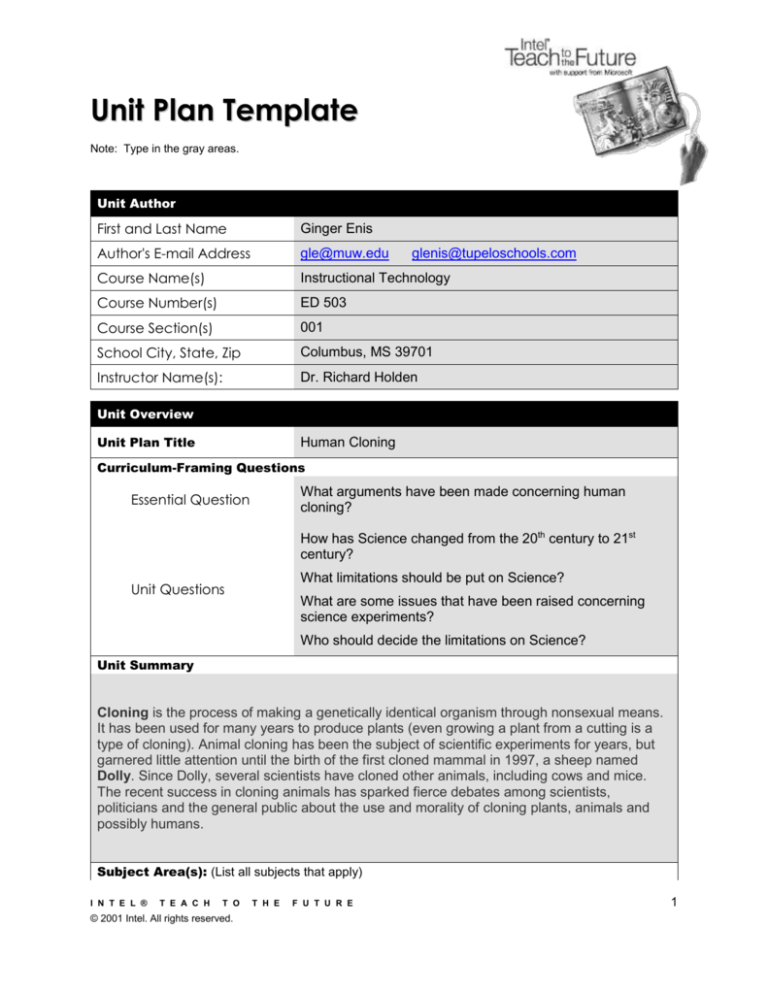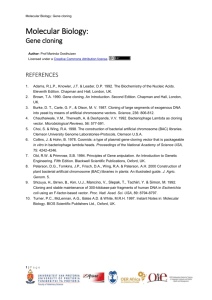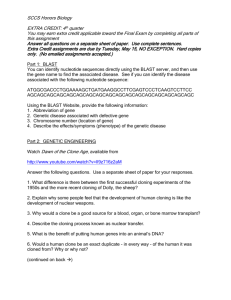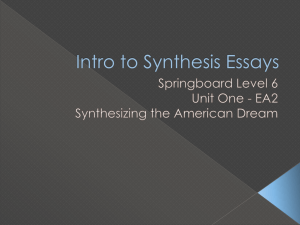
Unit Plan Template
Note: Type in the gray areas.
Unit Author
First and Last Name
Ginger Enis
Author's E-mail Address
gle@muw.edu
Course Name(s)
Instructional Technology
Course Number(s)
ED 503
Course Section(s)
001
School City, State, Zip
Columbus, MS 39701
Instructor Name(s):
Dr. Richard Holden
glenis@tupeloschools.com
Unit Overview
Unit Plan Title
Human Cloning
Curriculum-Framing Questions
What arguments have been made concerning human
cloning?
Essential Question
How has Science changed from the 20th century to 21st
century?
What limitations should be put on Science?
Unit Questions
What are some issues that have been raised concerning
science experiments?
Who should decide the limitations on Science?
Unit Summary
Cloning is the process of making a genetically identical organism through nonsexual means.
It has been used for many years to produce plants (even growing a plant from a cutting is a
type of cloning). Animal cloning has been the subject of scientific experiments for years, but
garnered little attention until the birth of the first cloned mammal in 1997, a sheep named
Dolly. Since Dolly, several scientists have cloned other animals, including cows and mice.
The recent success in cloning animals has sparked fierce debates among scientists,
politicians and the general public about the use and morality of cloning plants, animals and
possibly humans.
Subject Area(s): (List all subjects that apply)
I N T E L ®
T E A C H
T O
© 2001 Intel. All rights reserved.
T H E
F U T U R E
1
Biology, Physical Science
Grade Level (Click boxes of all grade levels that apply)
K-2
6-8
ESL
Gifted and Talented
3-5
9-12
Resource
Other: College
Student Objectives/Learning Outcomes
Provide a discussion of the moral issues involved in cloning.
Allow the students to interact in a debate session.
Discuss the pros and cons of cloning.
Discuss the advantages and the disadvantages of cloning.
Clear up any misconceptions regarding the process of cloning.
Understand the role of democratic decision making in accommodating human
dignity
and freedom of thought in the areas of science, medicine, and public health.
Learn the issues raised by genetic cloning and the scientific and public policy terms
used to discuss this area of science.
Explore the tensions between the protection of human dignity and the alleviation of
human suffering raised in the discussion of therapeutic cloning of human cells.
Analyze the reasons supporting and opposing therapeutic cloning of human cells.
Identify areas of agreement and disagreement with other students.
Decide, individually and as a group, whether the government should permit
therapeutic cloning of human cells; support decisions based on evidence and sound
reasoning.
Reflect on the value of deliberation when deciding issues in a democracy.
Targeted State Frameworks/Content Standards/Benchmarks
Investigate the biochemical basis of life. (L, P)
a. Identify the characteristics of living things.
b. Describe and differentiate between covalent and ionic bonds using examples of
each.
c. Describe the unique bonding and characteristics of water that makes it an
essential component of living systems.
d. Classify solutions using the pH scale and relate the importance of pH to
organism survival.
e. Compare the structure, properties and functions of carbohydrates, lipids,
proteins and nucleic acids in living organisms.
f. Explain how enzymes work and identify factors that can affect enzyme action.
Investigate cell structures, functions, and methods of reproduction. (L)
a. Differentiate between prokaryotic and eukaryotic cells.
b. Distinguish between plant and animal (eukaryotic) cell structures.
c. Identify and describe the structure and basic functions of the major eukaryotic
organelles.
d. Describe the way in which cells are organized in multi - cellular organisms.
I N T E L ®
T E A C H
T O
© 2001 Intel. All rights reserved.
T H E
F U T U R E
2
e. Relate cell membrane structure to its function in passive and active transport.
f. Describe the main events in the cell cycle and cell mitosis including differences
in plant and animal cell divisions.
g. Relate the importance of meiosis to sexual reproduction and the maintenance of
chromosome number.
h. Identify and distinguish among forms of asexual and sexual reproduction.
Utilize critical thinking and scientific problem solving in designing and
performing biological research and experimentation. (L, P, E)
a. Demonstrate the proper use and care for scientific equipment used in biology.
b. Observe and practice safe procedures in the classroom and laboratory.
c. Apply the components of scientific processes and methods in the classroom and
laboratory investigations.
d. Communicate results of scientific investigations in oral, written, and graphic
form.
Investigate chemical processes of the cell that maintain life. (L, P)
a. Relate chemical structure and characteristics of organic compounds to cell and
organism functions.
b. Investigate enzymatic reactions and identify factors that influence enzyme
activity.
c. Analyze light dependent and light independent reactions of photosynthesis with
respect to site, reactions involved and energy input/output.
d. Analyze processes of cellular respiration with respect to site, reactions involved,
and energy input/output in each stage.
Procedures
The students will be introduced to cloning and the history of it.
Approximate Time Needed (Example: 45 minutes, 4 hours, 1 year, etc.)
Varies- depends on grade level – 1 week to a semester
Prerequisite Skills
Materials and Resources Required For Unit
Technology – Hardware (Click boxes of all equipment needed.)
Camera
Laser Disk
Computer(s)
Printer
Digital Camera
Projection System
DVD Player
Scanner
Internet Connection
Television
VCR
Video Camera
Video Conferencing Equip.
Other:
Technology – Software (Click boxes of all software needed.)
I N T E L ®
T E A C H
T O
© 2001 Intel. All rights reserved.
T H E
F U T U R E
3
Database/Spreadsheet
Desktop Publishing
E-mail Software
Encyclopedia on CD-ROM
Image Processing
Internet Web Browser
Multimedia
Web Page Development
Word Processing
Other:
Printed Materials
Activity worksheet, handouts
Supplies
Websites, resources
Accommodations for Differentiated Instruction
Resource Student
Gifted Student
Student Assessment
Use the “Scoring Guide Rubric” to assess students' understanding of the topic and group
discussion skills
Have each student write and present a 2-3 minute commentary on the implications of human
cloning and whether or under what conditions it should continue. Students should include
ethical, legal, social and medical implications. Have students share their presentations with
the class.
Page 4 of 4









